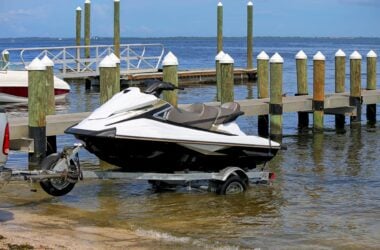Spring is here, and what does that mean? Time for dewinterization.
You’ve heard of winterizing: winterizing an RV, winterizing a boat, and winterizing a car But what about de-winterizing? It might not ring a bell.
Equally crucial, de-winterizing is a critical part of any spring home maintenance checklist.
After all, all that is winterized must be de-winterized.
But why is de-winterizing important? Remember, jumping back into RV season and boating season isn’t as simple as pulling your RV or boat out of storage and hitting the road (or the water). Similarly, when you winterize a vacant home, the spring sun won’t automatically reverse your winterization efforts.
You’ll need to complete the dewinterization process carefully. But first, you’ll need to understand why dewinterizing is important.
Jump to…
Why it’s Important to Dewinterize
Dewinterizing a Motorcycle, ATV, or Other Vehicle
What is Dewinterizing? (Winterizing vs. Dewinterizing)
Winterizing prepares a home or vehicle to spend the winter vacant (or unused). By winterizing a property or putting a vehicle in winter storage, you’re minimizing damage that results from cold weather.
Dewinterizing, on the other hand, is the reversal of your winterizing process, in other words, getting a building or vehicle ready to be regularly occupied or used again.
If you don’t de-winterize, you’ll find that many necessities, like your HVAC or hot water heater, don’t function properly post-winter.
Why it’s Important to Dewinterize
Dewinterizing ensures that your home or vehicle is in good working shape and won’t be damaged by regular use.
For example, you can prevent pipes from freezing by winterizing a home (e.g., adding antifreeze to the plumbing system). And when accounting for the cost of repairing frozen or burst pipes ($150 to $350), it’s clear how critical the winterization process really is. However, it’s just as important to flush the antifreeze from the pipes before drinking or using the water.
Once you’ve winterized your cabin, RV, or car, you must commit to de-winterization to ensure the longevity of your property.
Spring Dewinterizing Guide
Dewinterizing vehicles like motorcycles or jet skis is fairly straightforward, but the process of de-winterizing a vacation home or RV is a bit more complex.
You can use this guide to learn more about what de-winterization entails and its average cost.
Dewinterizing Your Home
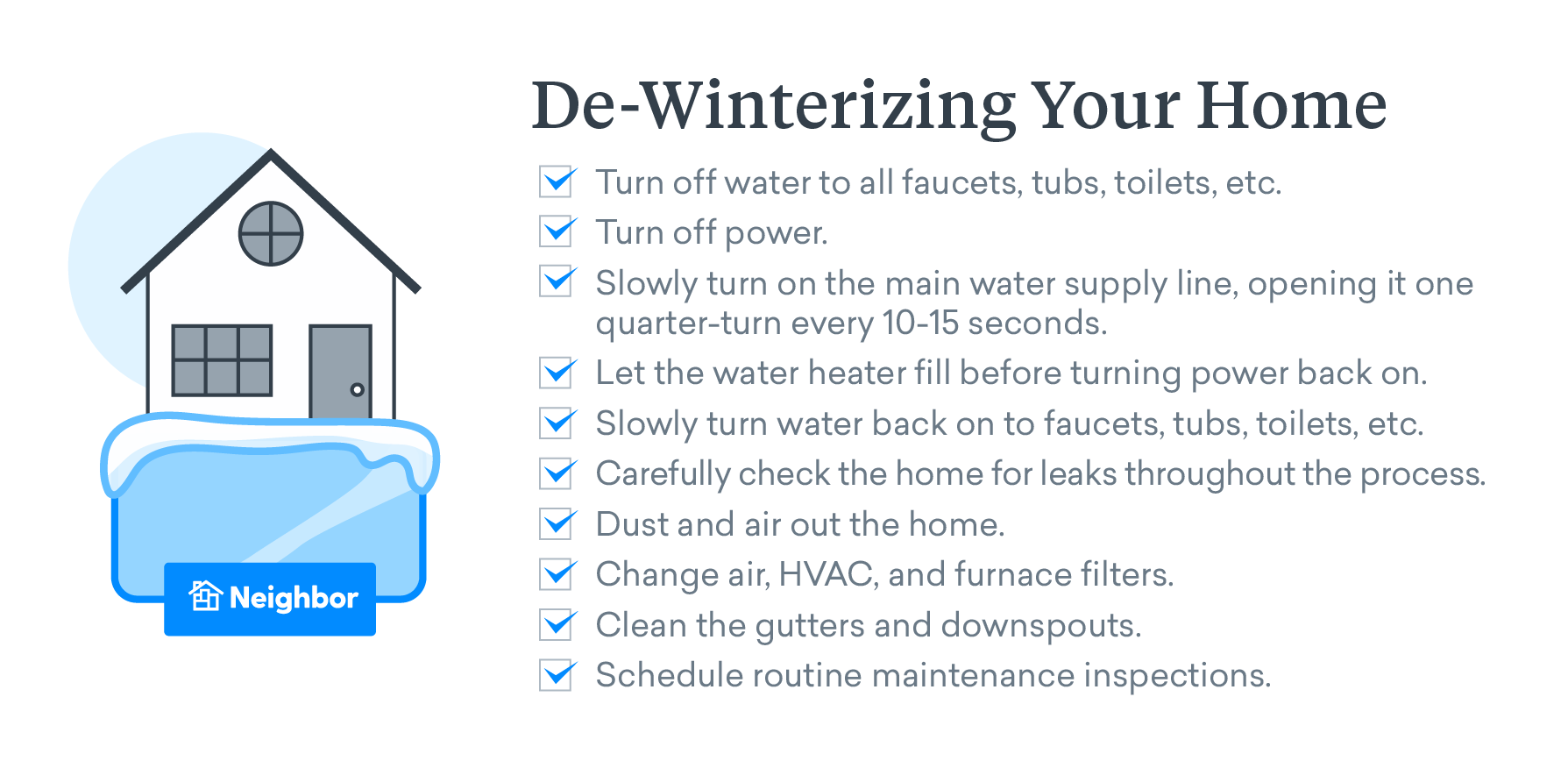
Cabins, vacation homes, or lake houses that are left vacant over winter should be winterized to protect their infrastructure. Depending on the scale of your project, professional winterization might cost anywhere from $2,000 to $4,000.
If you have experience working with plumbing and HVAC, de-winterization can be a fairly quick DIY project. But, if you’re not particularly handy, it might not be a bad idea to call a professional for a quote on de-winterization.
De-winterizing Pipes and Water System
The most important part of de-winterizing a home is taking care of the water system. Most companies that offer winterization services will shut off the water main and water heater, drain the pipes, and add traps to sinks, faucets, or drains.
If you’re confident in your plumbing skills, de-winterizing your home shouldn’t take long. You just have to be patient when opening the main water supply line.
Give the valve a quarter turn every 10-15 seconds to avoid shocking the pipes. The rest of the process is checking for leaks and filling the water lines. Overall, the process should take about an hour, and cost nothing.
However, if you’ve never worked with plumbing before or are worried about the integrity of your pipes, you should call a plumber to get your water system de-winterized. On average, a service call fee for a plumber is between $50 and $200.
How to De-winterize Your RV or Camper
Before you can hit the road for your first camping trip, you’ll need to de-winterize your RV. These tips provide a general outline to follow when sprucing up your RV, camper, or motorhome.
(Note: Some of these steps might not apply to your specific RV or camper)
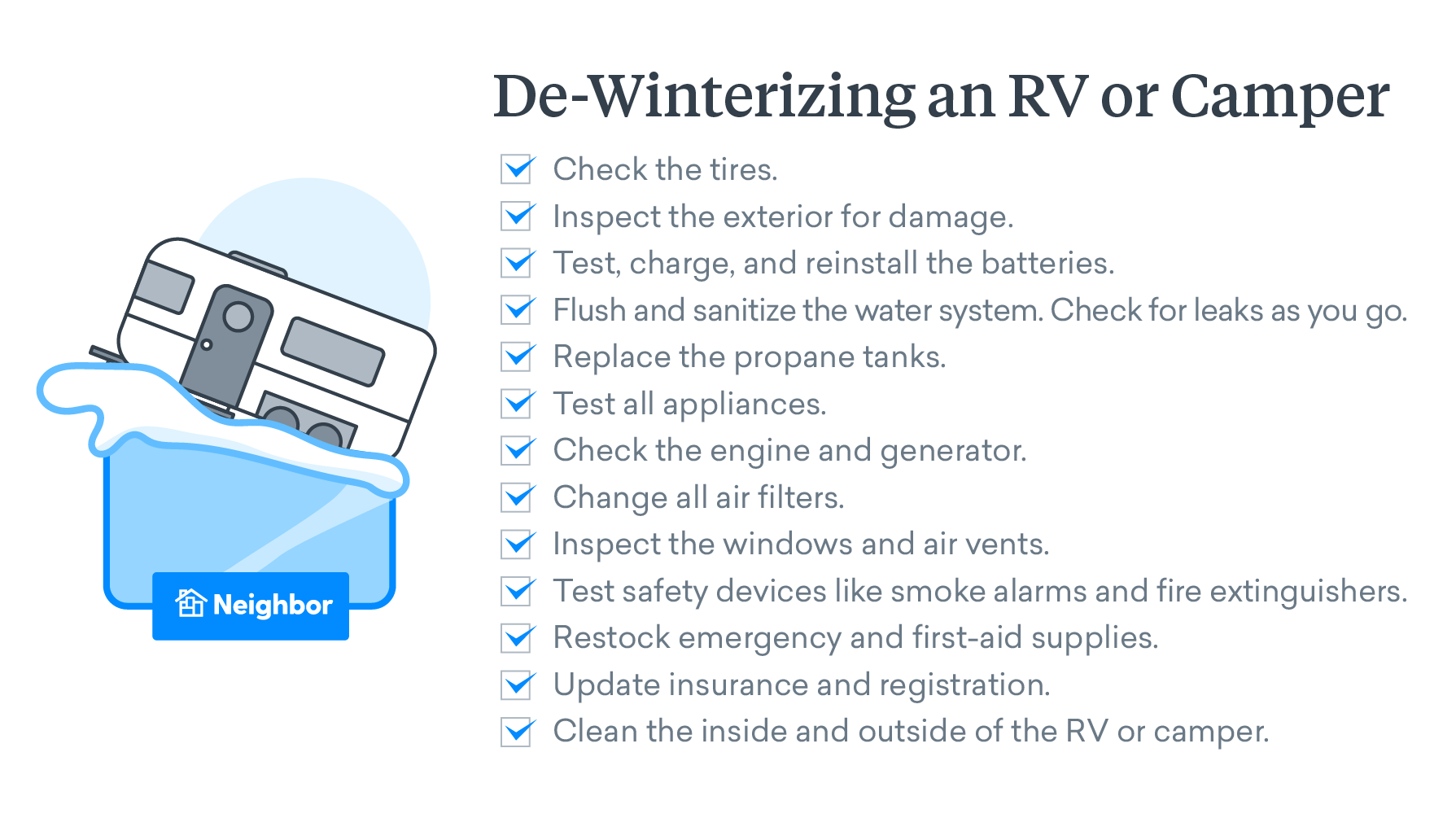
Barring any tire or battery replacements, it’s relatively inexpensive to de-winterize your RV. Your main expenses will be filling propane tanks, charging your AC, and hooking into city water to dump your tanks after cleaning. Overall, this will cost around $80 to $100.
RV Tires
- Check the air pressure of your RV’s tires. Each RV is different, so check the certification table or owner’s manual to find out the load and required PSI for your tires.
- Never exceed the PSI marked on the sidewall of the tire, usually between 60 and 80 PSI.
- Examine the tire sidewall for cracks or dry rot, replacing as needed
RV Batteries
- Test your RV battery, and charge or replace as necessary.
- Keep a spare RV battery with you in case of emergency.
RV Plumbing System
- Flush any RV antifreeze that was added to the system.
- Sanitize the fresh water tank to make sure any potable water is safe to drink.
- Leak-test the RV water system, including the water heater, water lines, and fresh water tank.
Propane System
- Replace propane tanks that are damaged and refill used tanks.
- Check propane appliances and gas lines for leaks
Other RV Preparation Tips
- Test all appliances, air conditioners, and the RV generator.
- Change air and water filters.
- Inspect windows and air vents, and let fresh air into the interior.
- Check safety devices like the smoke alarm, fire extinguisher, carbon monoxide detector, and LP detector.
- Restock safety equipment and first aid supplies
LEARN MORE: A complete guide on how to winterize a camper or trailer in the Fall.
3 RV Spring Cleaning Tips
All RV owners are probably familiar with that musty smell of a winterized cabin. Here are a few cleaning tips to get your RV ready for the camping season:
- Mix 1 cup of laundry bleach with 1 gallon of water to create a powerful bleach solution. Use a rag to wipe down vinyl or plastic surfaces.
- For cloth surfaces, add a mixture of vinegar and water to a spray bottle. This makes it easy to get an even coat over the surface.
- Add baking soda to a mason jar with a few drops of your favorite essential oil for a DIY air freshener to keep your RV or camper smelling fresh all season long.
How to De-winterize a Boat
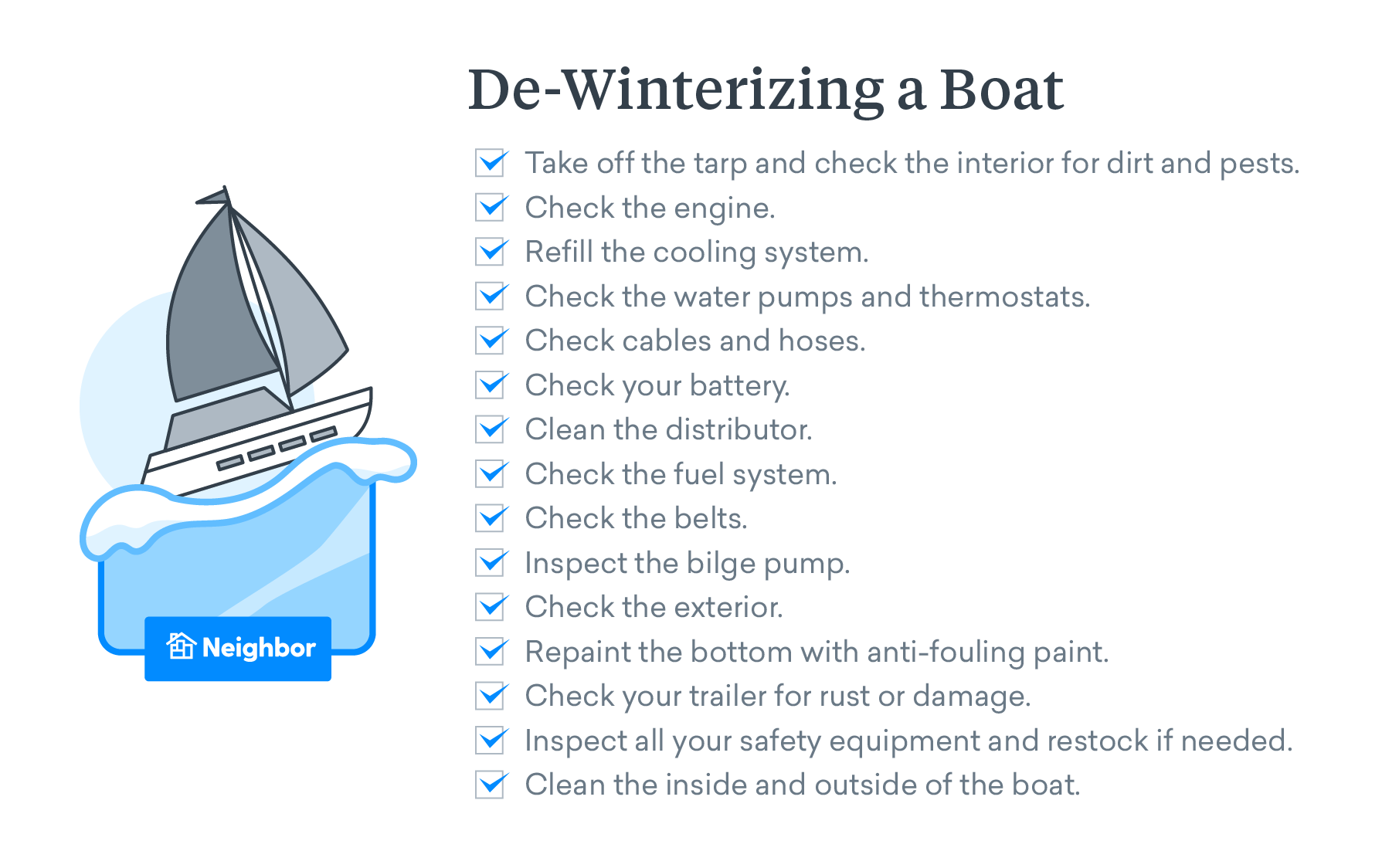
When you take your boat out of storage, you should always perform an oil change and idle the engine to make sure it runs properly. Then, use a voltage tester to check your battery. Most AGM batteries will have a voltage of 12.6-12.7.
Next, ensure the boat is water-tight by checking the bilge pump and drain plug. Spray down your boat with a garden hose to look for leaks.
Typically, cleaning and testing the boat takes longer than an oil change or maintenance, so expect to spend a few hours de-winterizing your boat.
Most boats require 4 to 7 quarts of motor oil, which will cost between $50 and $100, while a new battery will range from $100 to $500.
LEARN MORE: 5 easy steps on how to winterize a boat in the Fall.
How to De-winterize a Car

First off, you’ll want to check your tire pressure. Your owner’s manual will specify the PSI, which is usually around 30 to 35 PSI.
Next, check your car’s oil level, transmission, power steering, and windshield washer fluid. While you’re at it, be sure to hook a voltage tester up to your battery; an ideal charge for most 12v car batteries is between 12.6 and 14 volts.
You can do most of these tasks on your own, but many mechanics offer spring de-winterization packages, which are often around $75 to $100.
These deals might be worth it if you don’t want to spend money to change filters, properly dispose of used motor oil, or charge your air conditioner.
LEARN MORE: A complete guide on how to winterize a car in the Fall.
How to De-winterize a Jet Ski

The most important part of de-winterizing a jet ski is checking the seal on the engine bay. The rubber gaskets that keep salt and sand out of the engine compartment may have dried out or cracked, so always keep replacements handy.
If you did not replace the spark plugs when winterizing the jet ski, you’ll have to replace them to keep performance up to par. You’ll really only need a ⅝ spark plug socket and your new plugs, which should run you about $20-$25.
Depending on your experience, servicing a jet ski could take a few hours. Many people send their jet ski to a small engine mechanic, where a spark plug change alone could cost $200 or more.
How to Dewinterize a Motorcycle, ATV, or Other Vehicle
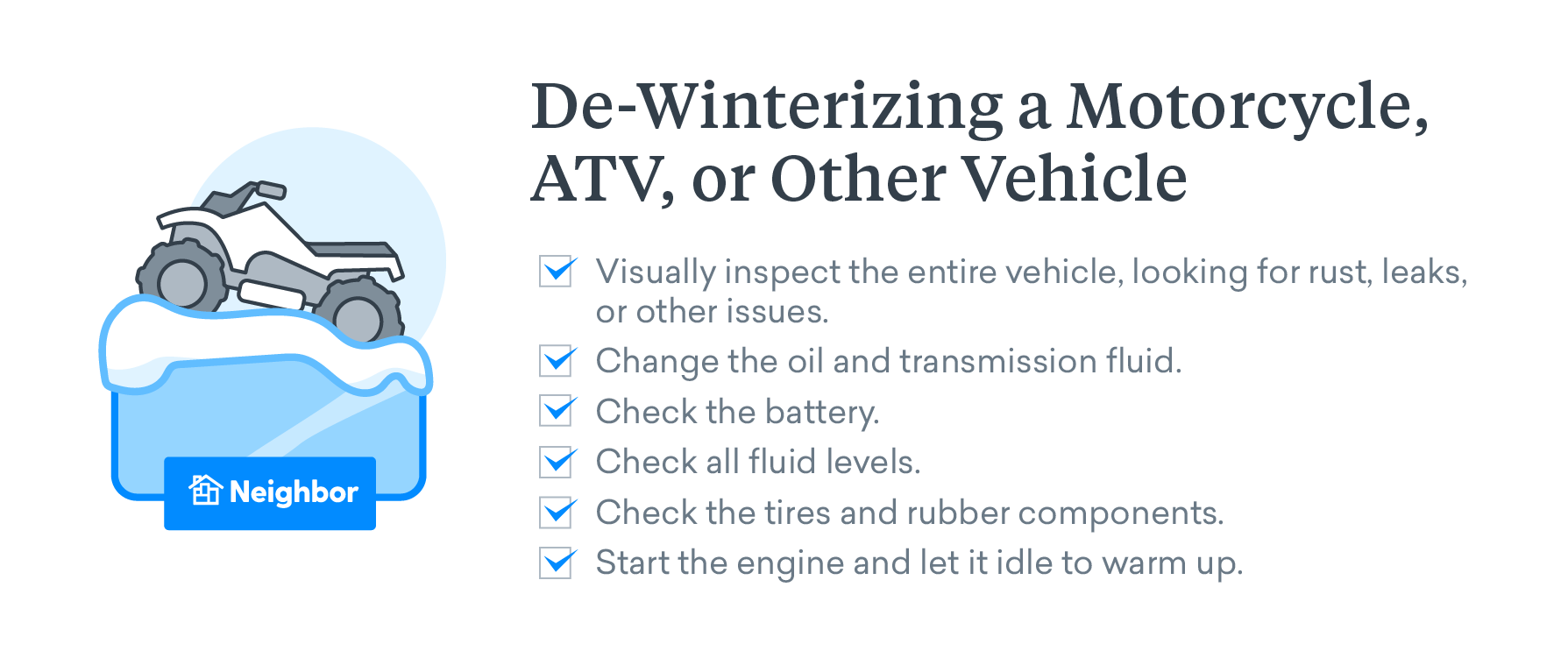
To de-winterize your motorbike or ATV you’ll need to inspect the vehicle mechanically. Using a voltage tester, check the charge of your motorcycle or ATV battery. The usual range is between 12 and 13 volts, so if it’s less, you’ll need to charge or replace the battery.
The next step is to perform an oil change and check the levels of your power steering and transmission fluid. Start the engine and let it idle to slowly warm up and work back into shape.
Overall, dewinterizing your motorcycle or ATV shouldn’t take longer than an hour. Full synthetic motor oil will run you about $40-$50, while a new mid-range battery will cost between $50 and $80.
Storage Solutions to Avoid De-winterizing Costs
If you have numerous vehicles, investment properties, or water toys to look after, de-winterizing them all can be a costly process. Engine oil, batteries, new tires, and other parts slowly add up to a hefty bill.
To reduce costs and protect your vehicles all winter long (without the need for winterization), consider storing your RV, summer car, or motorcycle in a temperature-controlled unit. Because climate-controlled storage can be costly, Using a peer-to-peer storage marketplace, like Neighbor’s local storage options, over traditional storage facilities can help you save money on climatized storage.

